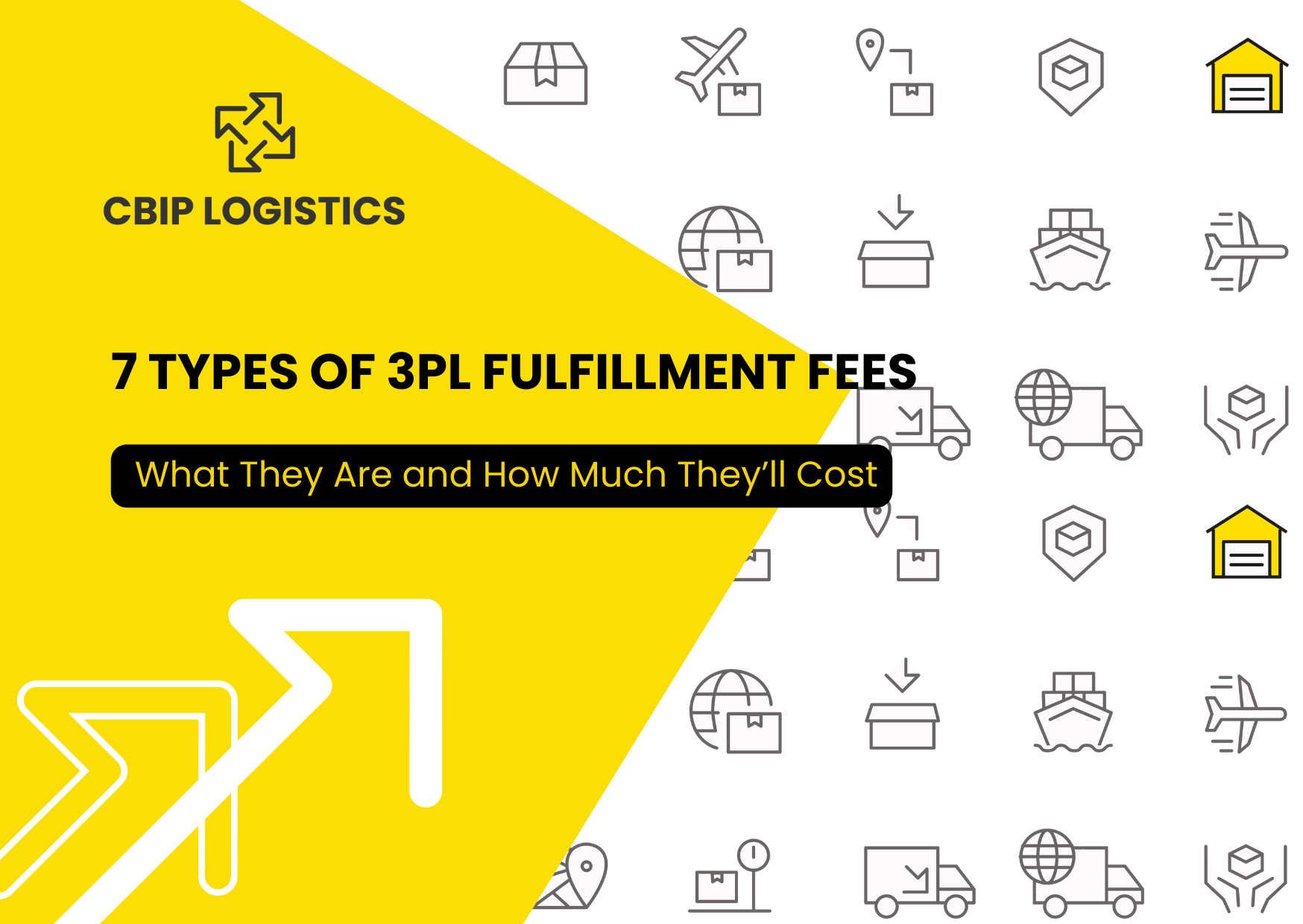The 7 Types of 3PL Fulfillment Fees and Their Typical Cost

The popularity of 3PL fulfillment has grown tremendously in the past 10 years. Now in 2023, an estimated 90% of Fortune 500 companies hire at least one 3PL provider.
Although it seems that everyone is using third-party logistics providers for easy fulfillment, not everyone understands the costs associated.
Retailers aren’t to blame for getting confused — costs vary quite a bit between different 3PLs, depending on how they operate and where they're located.
Since the fees and costs vary, it can be difficult to nail down exactly how much you can expect to spend using a 3PL service. However, there are some standard fees that you will see across the board.
Understanding what these fees are will help you estimate a budget before you get the invoice from your 3PL.
Ready to learn what costs you will face when working with a 3PL fulfillment service? Read on to learn about the basic components that make up logistics pricing.
Understanding 3PL Fulfillment Costs
Understanding the different components of your 3PL bill is important for estimating profit and managing your inventory. There are 7 main fees you will need to plan for — read on to see what they are and how much each will cost you.
Cost #1: Onboarding and Setup Fee
This expense covers the initial setup of technology, linking your marketplaces or front stores to the 3PL's Warehouse Management System (WMS) or Order Management System (OMS).
This initial link ensures that your marketplace and the 3PL’s WMS/OMS become one seamless unit. When a task needs completing, it can be automated throughout both systems, without the need for manual entry.
To illustrate, when you connect your Shopify store to the 3PL's WMS, orders from your Shopify store are automatically transmitted to their system. This allows their team to promptly initiate order fulfillment without you having to manually send daily order CSV files.
Typically, this fee is a one-time charge and usually falls within the range of USD 100 to USD 1000, subject to your location.
Cost #2: Receiving inventory
This is sometimes referred to as inbound fees, handling in, or inventory in. What's important is understanding that this step involves your stock arriving at the 3PL's warehouse and what they do with it when it does. This fee includes everything the 3PL needs to do with your stock before putting it on the warehouse shelves.
The 3PL team unloads the stock from the vehicle, opens the boxes to count the units against the packing list or shipping notice, and reports any product damage. Finally, they enter inventory data into their WMS and apply labels if necessary.
Here's a breakdown of typical pricing:
- Per pallet: Usually ranges from USD 5 to USD 20
- Hourly basis: Typically falls between USD 25 and USD80 per hour
- Per unit (piece): Varies from USD 0.2 to USD 4 per unit
- Per box: Generally, ranges from USD 1 to USD 5 per box
The pricing is determined based on the characteristics of the product. This means that the cost of receiving, for instance, a large chair would be different from that of a lipstick.
Cost #3: Storage
Storage expenses typically make up around 50% of your overall 3PL bill.
This cost is based on the amount of space your inventory occupies in the fulfillment center, and you are billed for storage on a daily, weekly, or monthly basis, depending on the specific methodology employed by the 3PL. The unit used for charging may also vary.
In Canada and the US, the majority of 3PL fulfillment centers have storage pricing as follows:
- Per pallet per month: Usually ranges from USD 20 to USD 30
- Per bin per month: Typically falls between USD 2.5 and USD 6
Whereas in the Australian market, storage charges may be structured as follows:
- Per pallet per week: Varies from AUD 15 to AUD 20
- Per CBM (cubic meter) per month: Typically ranges from AUD 15 to AUD 30
- Per bin per week: Generally falls between AUD 1.5 and AUD 6
*If your products require special storage conditions, such as temperature-controlled warehouses, the cost may be slightly higher than the prices mentioned above.
Cost #4: Order Fee
The order fee is an additional charge that may or may not be imposed by the 3PL.
Certain 3PLs apply this fee using their WMS technology, which allocates it to each order. Others include it in the monthly bill. The cost of the order fee typically falls within the range of USD 1 to USD 2 per order.
Note, that the unit of measurement (UOM) for this fee is per order. So, if an order consists of multiple SKUs or items, you would only be charged a single fee of USD 2 for the entire order, rather than multiplying the fee by the number of SKUs in the order.
Cost #5: Pick and Pack Fee
The pick and pack fee covers the process of the 3PL team picking the products for an order, packing them, and affixing the shipping label.
Please note: The pick-and-pack fee may or may not include the cost of packing materials. Some 3PLs choose to charge packing materials separately due to their higher costs.
Here's an example of the fees involved:
- Pick and pack fee: Generally ranges from USD 0.5 to USD 5 (packing materials not included)
- Packing fee: Typically charged at cost or falls within the range of USD 0.1 to USD 0.5 for satchels, and USD 1 to USD 3 for cartons.
Cost #6: Technology Fee
As previously mentioned, some fulfillment centers may impose a technology fee, which typically ranges from USD 100 to USD 500 per month.
This fee covers the systems they use to facilitate order management, inventory tracking, and other operational processes.
Cost #7: Account Management Fee
While the first 6 costs are operational fees, the account management fee is more related to the customer service your 3PL provides.
Typically, this fee covers communications with your team for all account-related matters, namely reporting, contracts, pricing, billing, planning, etc. This also covers any inquiries related to inventory, orders, and shipments. Some 3PLs even provide customer support for shipping and order inquiries from your customers.
The average account management fee typically falls within the range of USD 50 to USD 1000 per month, or an hourly rate ranging between USD 30 and USD 90.
Cost #8: Return Fee (Reverse Logistics)
This fee covers everything your 3PL has to do when they receive returned items.
Upon receiving the returned products, the 3PL performs a quality check (QC) to ensure their condition. Depending on the outcome, the items are either returned to the inventory or stored separately in an isolated location.
It's important to note that the 3PL will charge a return fee to cover the handling of these returned items.
Typically, the return fee ranges from USD 1 to USD 6 per item, reflecting the costs associated with the processing and management of reverse logistics.
Why are retailers switching from 3PL to 4PL?
Trying to find and manage the right 3PLs while growing your online brand is a lot of work. Managing your logistics operations can be extremely overwhelming, and it takes away from the time you could be spending improving your business in other areas.
Many DTC brands have decided to redirect time and resources to improving their businesses by handing over the reins to a 4PL.
When you work with a 4PL like CBIP Logistics, you don’t just get a logistics service — you get a logistics partner. That partner will design a personalized logistics operation for you, manage and integrate every part of your supply chain, and be ready to step in and help if things go off the rails.
On behalf of CBIP Logistics, I would like to invite you to reach out to us if you’d like to learn more about ways to better manage your fulfillment.
Should you want to learn more or have an immediate fulfillment need, feel free to book a call with me here.
Thank you for reading, and I look forward to connecting with you again in our next blog!
Thao Nguyen
Sales & Marketing Manager






